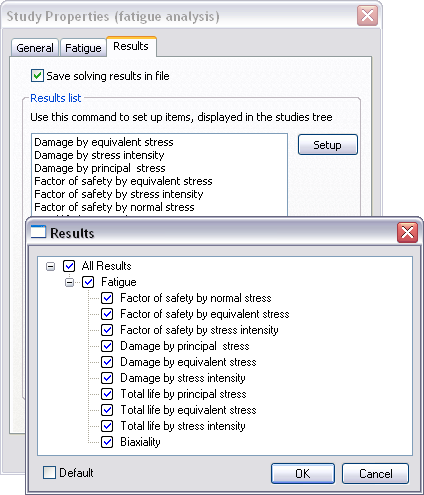 |
AutoFEM Analysis Results of Fatigue Analysis | ||||||
Results of fatigue analysis
After performing the calculation a new folder ("Results") is created into the tree of study. You can specify the list of displayed results on the "Results" tab of the "Study properties (Fatigue Analysis)" dialogue.

In all the ten results are available for the fatigue analysis. They can be divided into four groups.
Group "Damage" includes the following results:
•damage by principal stresses (hypothesis 3);
•damage by equivalent stresses (hypothesis 2);
•damage by stress intensity (hypothesis 1);
This result is displayed in percentage and indicates the damage rate of the structure under the action of cyclic stresses at a specified the number and nature of loading cycles.
If the design submitted to n1 cycles of alternating stress S1, n2 cycles of alternating stress S2, n3 cycles of alternating stress S3, ..., nk cycles of alternating stress Sk, then the total damage rate D is calculated as: D = n1 / N1 + n2/N2 + n3/N3 +...+ nk/Nk , where Ni is the number of cycles required to cause destruction by Si.
+...+ nk/Nk , where Ni is the number of cycles required to cause destruction by Si.
Group "Total Life" (this type of result is available only for single-event fatigue analysis study) includes the following results:
•total life by principal stresses;
•total life by equivalent stresses;
•total life by stress intensity.
This result shows the minimum number of cycles Nmin, required to cause fatigue failure.
Group "Factor of safety" (this type of result is available only for the single-event fatigue analysis study) includes results:
•factor of safety by the maximum principal stresses (hypothesis 3).
•factor of safety by equivalent stresses (hypothesis 2);
•factor of safety by stress intensity (hypothesis 1);
The factor of safety is the ratio of fatigue limit σR, defined for a given fatigue curve for a given number of loading cycles, adjusted to the amplitude of the cycle σ*,which is calculated from the calculations in the problem of static stress analysis σ:
![]()
The stresses σ are calculated on the basis of the relevant conditions of plasticity:
are calculated on the basis of the relevant conditions of plasticity:
•the distortion energy hypothesis:
![]() ;
;
•the hypothesis of maximum shear stresses:
![]() ;
;
•the largest principal stress hypothesis:
![]() .
.
Group "Biaxiality" (this type of result is available only for the single-event fatigue analysis study) includes the following result:
Biaxiality is the ratio of the smaller alternating principal stress (different from 0) to a larger alternating principal stress:
![]() .
.
This result characterizes the inequality of the amplitudes of the principal stresses in the point and describes the spatial distribution of unevenness of the principal stresses on the volume of the body at every point. The value of the biaxiality equal to 1 corresponds to the case of equal stress state σ1=σ2=σ3 at the point.